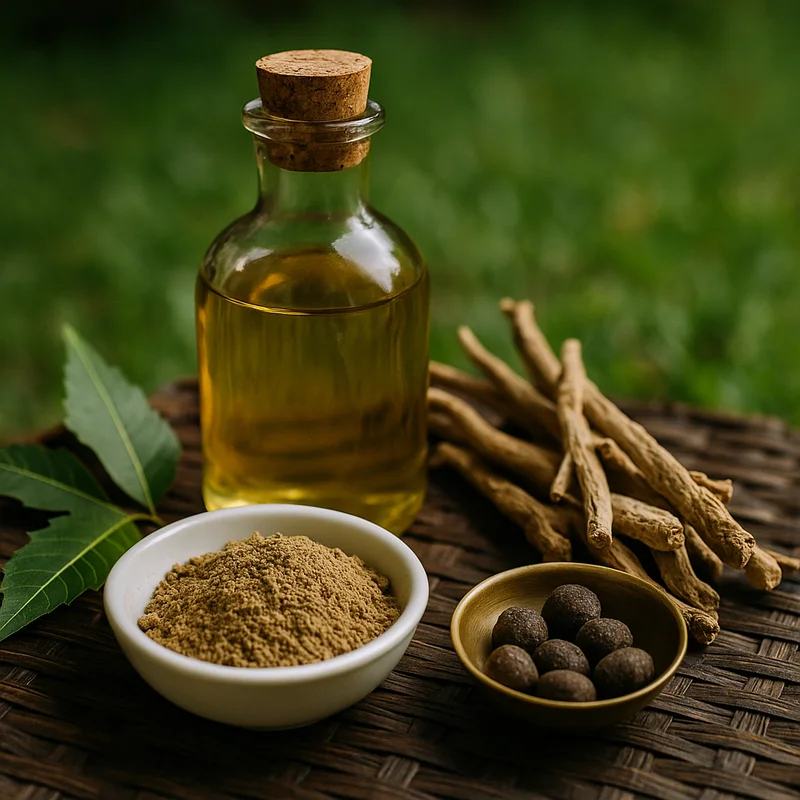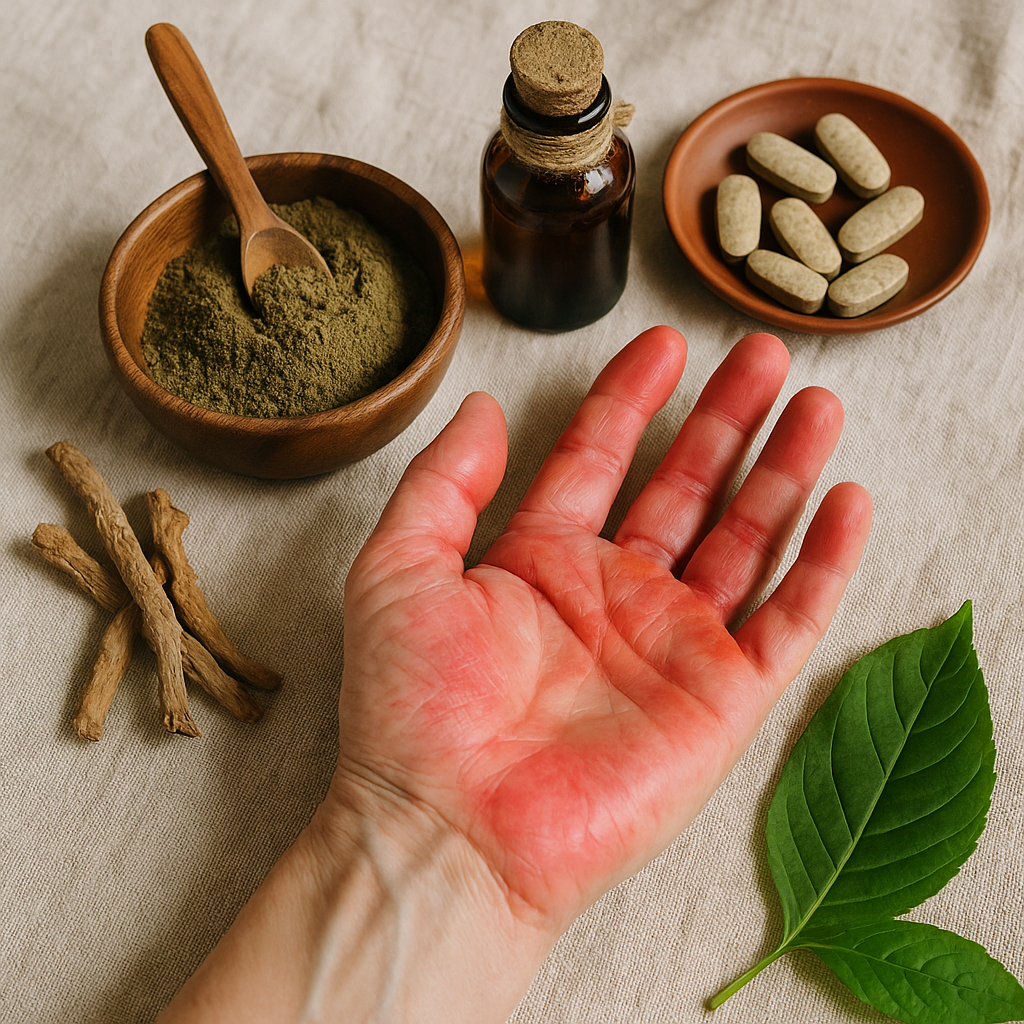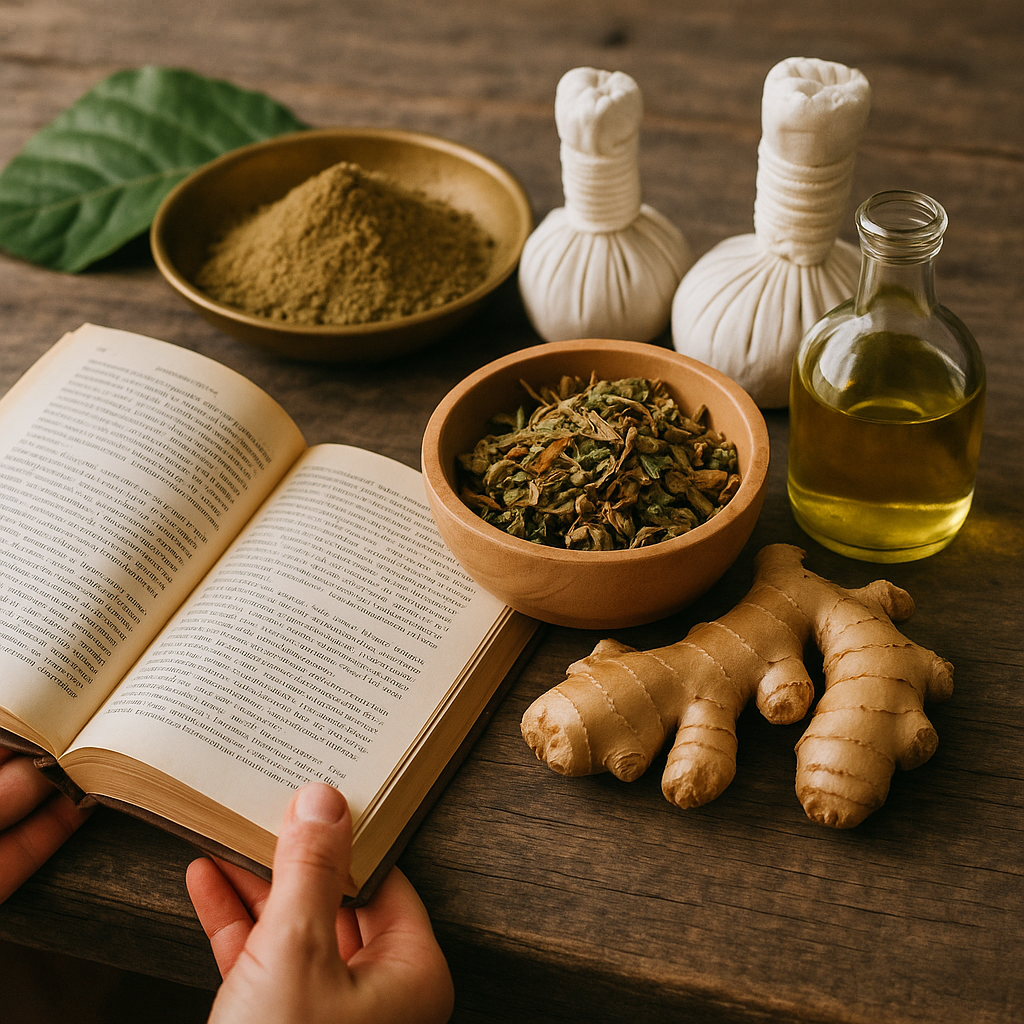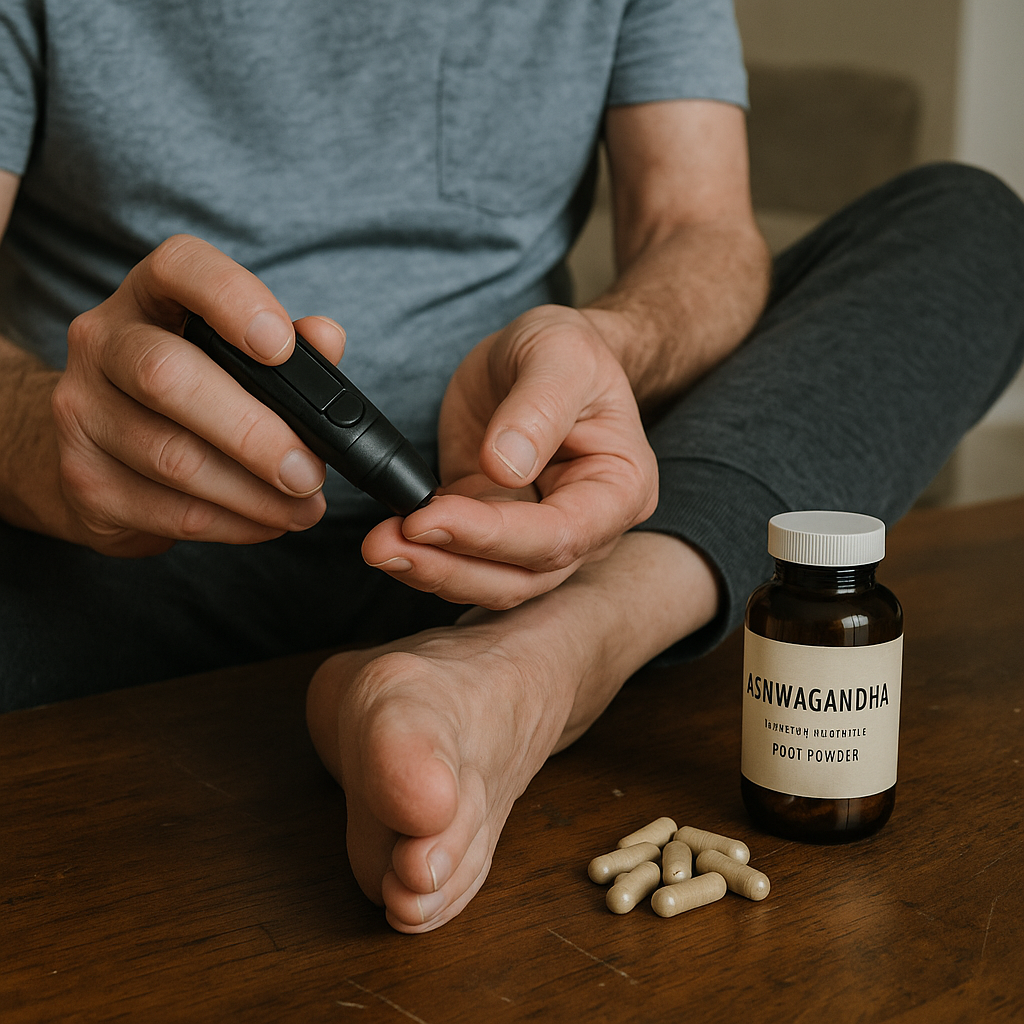Ask Ayurvedic doctor a question and get a consultation online on the problem of your concern in a free or paid mode. More than 2,000 experienced doctors work and wait for your questions on our site and help users to solve their health problems every day.
Shop Now in Our Store
Ayurvedic Medicine for Peripheral Neuropathy: An Ancient Answer to Modern Nerve Pain

Introduction
Peripheral neuropathy. Sounds clinical, doesn’t it? Cold, detached — like something you’d hear in a sterile doctor’s office while staring blankly at a prescription pad. But the reality of it? Oh, it’s anything but detached. It’s raw. It tingles. It burns. Sometimes it’s numb, other times it’s on fire. For many people — maybe even you — it's an invisible companion that never quite leaves.
So here’s where Ayurveda walks in — barefoot, incense wafting, calm and ancient and very different from your neurologist’s toolkit. Ayurvedic medicine for peripheral neuropathy doesn’t just look at nerve endings and neurotransmitters; it looks at you. Your constitution, your energy (prana), your digestive fire (agni), and even how much stress you’re secretly swallowing on a daily basis.
Why is this relevant now? Because people are tired — not just physically, but soul-deep weary — of trying pills that numb the pain without healing the cause. There’s a rising wave of folks turning back to nature, to traditional systems that have endured for thousands of years. Ayurveda, with its gentle herbs, personalized recommendations, and focus on balance, is leading that movement — especially for chronic conditions like neuropathy where modern medicine often hits a frustrating wall.
And it’s not just herbs. It’s also about oil massages (abhyanga), cleansing therapies (panchakarma), diet corrections, and lifestyle rhythms that support the nervous system. It’s like tuning an instrument — and guess what, your nerves? They’re very much in need of tuning.
So, if you’re curious, skeptical, desperate, or just wandering through the internet late at night looking for something — anything — that might help with that persistent tingling in your feet… you're in the right place.
Let’s dig into this. We’ll look at what Ayurvedic medicine for peripheral neuropathy actually is, where it comes from, and how it might just be the thing your nerves have been craving.

What is Ayurvedic Medicine for Peripheral Neuropathy?
Peripheral neuropathy, in the biomedical sense, is a condition where nerves outside the brain and spinal cord get damaged. It can come from diabetes, infections, chemotherapy, alcohol abuse, vitamin deficiencies, or sometimes — just bad luck and genetics. But in Ayurveda, it’s not viewed as a collection of disconnected symptoms. It’s understood more holistically — as a systemic imbalance of energies in the body.
Definition and Origin of Ayurvedic Medicine for Peripheral Neuropathy
In Ayurvedic terms, peripheral neuropathy usually correlates with Vatavyadhi — disorders caused by an aggravated Vata dosha. Vata, as you might know, governs movement, nerve impulses, and sensory functions. When it goes haywire — too dry, too fast, too irregular — the nervous system suffers.
So Ayurvedic medicine for peripheral neuropathy isn’t a “take this herb and be done with it” situation. It’s a broader approach, addressing Vata’s disruption through calming, nourishing, grounding interventions — inside and out.
The word “medicine” here is a little misleading too. It’s not just tablets or tonics. It includes food, routine, sleep, behavior, even how and when you think. Ayurveda doesn’t really draw a firm line between “medicine” and “lifestyle.” The whole life is the medicine.
Historical Use in Ayurveda
The roots go deep — Charaka Samhita, Sushruta Samhita, and Ashtanga Hridaya (the three main classical Ayurvedic texts) all describe nervous system disorders under Vatavyadhi. They speak of pakshaghata (paralysis), gridhrasi (sciatica), and katigraha (lower back stiffness) — all Vata-related and nerve-centric.
Back then, they didn’t have words like “neuropathy” or “nerve conduction velocity,” but they did observe patterns: numbness, weakness, loss of sensation, burning pain. And they treated it with a combination of herbal decoctions, oil applications, bastis (medicated enemas), and dietary protocols.
Fast forward to today, and Ayurvedic practitioners are applying those same principles — slightly modernized, sure — to help people manage peripheral neuropathy with surprising success.
Cultivation and Harvesting Details (If Applicable)
If we’re talking specific herbs used in Ayurvedic neuropathy treatment — like Ashwagandha, Bala, Shatavari, or Nirgundi — then yes, cultivation becomes relevant.
Take Ashwagandha (Withania somnifera), a powerhouse adaptogen. It grows mostly in dry regions of India, harvested usually in winter when the roots are mature. The quality of the root — potency, taste, color — depends on the soil, sun exposure, and how it's dried and stored.
Bala (Sida cordifolia), often used to strengthen nerves and muscles, is harvested for its roots and stems. Ideally, it should be collected after flowering for maximum strength.
And let’s not forget the oils — Mahanarayan taila, Ksheerabala taila — these aren’t just “applied externally.” They're carefully prepared using herbal decoctions, sesame oil, cow’s milk, and often cooked for hours. That process matters. The preparation is part of the healing.
So yeah, this stuff isn’t mass-manufactured pharma. It’s more like — well — slow medicine. And maybe that’s what makes it so potent.
Key Components and Active Substances in Ayurvedic Medicine for Peripheral Neuropathy
Let’s get a bit geeky for a second. Not test-tube, petri-dish geeky — more like forest-walk-and-ask-the-herbalist geeky. Because if Ayurvedic medicine for peripheral neuropathy works (and for many people, it does), then the “why” is buried in the roots, leaves, and oils that make it up.
Chemical Composition and Active Ingredients
Ayurvedic herbs used in neuropathy aren’t randomly thrown together — they’re selected for their rasayana (rejuvenating), vatashamak (Vata-balancing), and nervine properties. A few stars of the show:
-
Ashwagandha (Withania somnifera): Contains withanolides — natural steroids with anti-inflammatory, antioxidant, and neuroprotective effects. Think of it as the nervous system’s cozy sweater.
-
Bala (Sida cordifolia): Rich in ephedrine alkaloids and phytosterols. It strengthens muscles, reduces pain, and tones the nerves.
-
Guduchi (Tinospora cordifolia): A bitter immune booster with alkaloids and diterpenoid lactones that cool and calm the system.
-
Brahmi (Bacopa monnieri): Contains bacosides, which support cognition, reduce oxidative stress, and help regenerate nerve endings.
-
Shatavari (Asparagus racemosus): Saponins and isoflavones galore — deeply nourishing, especially for burnt-out folks.
You see the theme? Adaptogens. Anti-inflammatories. Tonics. Not one-trick ponies — these herbs multitask like over-caffeinated parents.
How the Components Affect the Body
Each herb works on multiple levels. Take Ashwagandha — it doesn’t just chill you out, it tones the adrenal glands, balances cortisol, and indirectly protects neurons from stress-induced degeneration.
Brahmi, on the other hand, increases cerebral blood flow, boosts antioxidant enzymes in the brain, and has been shown to help with cognitive dysfunction — a side benefit for those with neuropathy-related brain fog.
The oils — oh, don’t underestimate them. When you massage with Mahanarayan taila or Ksheerabala taila, you're not just greasing the skin. The oils penetrate the pores, reach the srotas (channels), and nourish the majja dhatu (nerve tissue).
Ayurveda loves this layered action — the physical, emotional, and energetic body all addressed at once.
Comparison with Similar Ayurvedic Remedies
You might be wondering: okay, but how does this compare with, say, Triphala or Trikatu?
Well, Triphala is more of a detoxifier — brilliant for digestion and absorption, but not directly for nerves. Trikatu’s all fire and spice — great for sluggish digestion and Kapha disorders, not so much for Vata-aggravated conditions like neuropathy.
So while they’re helpful adjuncts, they’re not front-line soldiers in the fight against peripheral nerve degeneration. For that, you want grounding, nourishing, Vata-pacifying powerhouses — and that's where the herbs above shine.

Health Benefits and Therapeutic Uses of Ayurvedic Medicine for Peripheral Neuropathy
Alright, let’s get to the good stuff: how this actually helps. Because reading about saponins and doshas is fine, but what people really want to know is: “Will this stop the burning in my feet?”
Fair question. Let’s break it down.
Physical Health Benefits
Most people with peripheral neuropathy are dealing with pain, numbness, tingling, hypersensitivity, or loss of balance. Ayurvedic medicine addresses this in a few powerful ways:
-
Reduces inflammation in nerves (especially with Ashwagandha, Guggulu, and turmeric-based formulas).
-
Improves nerve conduction and regeneration (Brahmi and Guduchi are key here).
-
Enhances circulation, particularly with oils and fomentation therapies.
-
Supports digestion and assimilation — which matters, because poor gut health = poor nerve nutrition.
-
Strengthens immunity, which is crucial if your neuropathy is autoimmune-related (hello, Guillain-Barré folks).
And remember: Ayurveda doesn’t treat the disease; it treats you. So if your neuropathy is from diabetes, the protocol may include bitter herbs and blood sugar support. If it’s post-viral, the focus might be more on rasayana and rejuvenation.
Mental and Emotional Health Benefits
Chronic nerve pain messes with your mind. It’s draining. It can make you anxious, irritable, or low-key depressed — especially when it disrupts your sleep.
Here’s where herbs like Brahmi, Jatamansi, and Mandukaparni come in. They soothe the nervous system, calm excess Vata in the mind, and help restore mental clarity and emotional resilience. Ayurvedic therapy doesn’t separate the mind from the body — it knows they’re tangled up in one messy, beautiful system.
Most Effective Use Cases
Where does Ayurvedic medicine for peripheral neuropathy really shine?
-
Diabetic neuropathy (the big one — especially with sugar-regulating herbs)
-
Chemo-induced neuropathy (when the body needs gentleness, not more chemicals)
-
Post-herpetic neuralgia (Ayurveda can help soothe the lingering nerve pain)
-
Idiopathic neuropathy (when doctors don’t know what’s wrong, but Ayurveda sees a pattern)
It might take time. Weeks. Maybe months. But the healing tends to be deep and lasting.
Use in Integrated Ayurvedic Therapy
A full Ayurvedic plan isn’t just pills and powders.
You might get a combo of:
-
Abhyanga (oil massage with medicated oils)
-
Swedana (herbal steam to loosen stiffness)
-
Basti (oil or decoction enema — sounds weird, works wonders for Vata disorders)
-
Dietary tweaks — warm, moist, grounding foods
-
Sleep and lifestyle rhythms to support nerve repair
It’s not always convenient. But it’s thorough. And sometimes that’s what real healing needs.
Indications and Contraindications of Ayurvedic Medicine for Peripheral Neuropathy
Ayurveda is generous, but it’s not naive. Just because something is “natural” doesn’t mean it’s safe for everyone.
Health Conditions Where It’s Recommended
-
Type 2 Diabetes (with peripheral symptoms)
-
Chronic stress-related fatigue
-
Sciatica and spinal compression injuries
-
Vata-dominant individuals with dry skin, insomnia, anxiety, and nerve sensitivity
-
Menopausal nerve pain or tingling in limbs
-
Chemotherapy recovery support
In short, if your nervous system feels frazzled, dry, depleted, or inflamed — this approach is likely worth considering.
Possible Side Effects and Contraindications
-
Ashwagandha may overstimulate some people — especially those with hyperthyroidism.
-
Oil bastis can cause digestive upset if done improperly or on a full stomach.
-
Heavy herbs like Bala may not suit people with sluggish digestion or excess Kapha.
-
Overuse of rasayanas can lead to imbalance — yep, even good things can be too much.
Also, don’t self-diagnose. Really. Ayurvedic medicine works best when tailored to your dosha, your current imbalances, and the root cause — not just symptoms.
Restrictions Based on Age, Health Status, or Drug Interactions
-
Elderly patients: Go slow. Start with diet and mild therapies.
-
Pregnant women: Avoid potent rasayana herbs unless supervised.
-
People on blood thinners or antidepressants: Some Ayurvedic herbs may interact — always consult a practitioner.
-
Children: Milder, gentler forms only — think ghee, warm milk infusions, light massage.
So yes — personalized care is not just nice to have. It’s essential.
How to Properly Use Ayurvedic Medicine for Peripheral Neuropathy
Alright, let’s get practical. You’ve read the theory, the herbs, the benefits — but how do you actually take this stuff?
Recommended Forms and Dosages
You’ll typically find these medicines in:
-
Churna (powder): Great for teas and infusions.
-
Kashayam (decoction): Stronger, bitter, but more potent.
-
Vati/Gutika (tablet/pill): Convenient, but sometimes less effective.
-
Taila/Ghrita (oil/ghee): Used both internally and externally.
Dosages vary wildly depending on the herb and your constitution. But generally:
-
Ashwagandha powder: 3–6g/day with warm milk or water
-
Brahmi syrup: 5–10ml twice daily
-
Mahanarayan oil massage: Daily or every other day before bath
-
Basti treatments: As prescribed, usually in a clinical setting
Best Time to Take It / Dosage Schedule
-
Morning: For most rasayanas and adaptogens
-
Evening: For calming herbs like Brahmi or Jatamansi
-
Before meals: If focusing on digestion
-
After meals: If you're worried about nausea or heat
Consistency > perfection. It's better to take small doses daily than binge once a week.
Recipes and Practical Advice
Feeling DIY? Here’s a basic Ashwagandha milk:
Boil 1 tsp Ashwagandha powder in 1 cup milk (plant-based is okay, but cow's milk is traditional). Add a pinch of cardamom. Simmer for 5 minutes. Sweeten with jaggery if needed. Drink before bed.
Also, apply warm Bala oil on your feet before sleep. Throw on socks. Wake up with happier toes.
Sounds simple, right? It is. But it works.

Success Stories and Real-Life Examples (Case Studies)
Now, let’s get out of theory-land for a second. Because what really makes people believe in a system — especially one as ancient and poetic as Ayurveda — are the stories. The humans behind the herbs.
Case 1: Diabetic Neuropathy and Ashwagandha Routine
Rajiv, 58, had been living with Type 2 diabetes for over a decade. He described the pain in his feet as “like walking on glass shards soaked in chili.” Harsh. And the medications weren’t helping much, just dulling things a bit.
A friend nudged him toward an Ayurvedic doctor. His protocol? Daily Ashwagandha with warm milk, foot massages with Mahanarayan oil, and a strict anti-Vata diet — warm foods, no raw salads, plenty of ghee.
It didn’t happen overnight. But after two months? The sharp pain softened. After four months, he stopped waking up from burning feet at 3 a.m. He still checks his blood sugar and respects modern medicine, but now he swears by his “oil and herb ritual.”
Case 2: Post-Chemo Nerve Recovery
Simran, 43, had survived breast cancer. But the neuropathy left from chemotherapy felt like punishment after survival — tingling in her hands, clumsiness, frustration.
Her oncologist was sympathetic but had no fixes. She turned to Ayurveda as a sort of “Hail Mary.” The plan: Brahmi syrup, gentle yoga, medicated ghee, and weekly basti therapy at a local clinic.
After six weeks, she noticed her grip strength improving. Her sleep, which had been a wreck, normalized. And emotionally? She felt like herself again — grounded, stable, calm.
Stories like these aren’t miracles. They’re just… reminders that healing is possible. Sometimes in slower, richer, more whole-body ways.
Scientific Research and Evidence of Effectiveness of Ayurvedic Medicine for Peripheral Neuropathy
You might be thinking — okay, but is this just feel-good storytelling, or does the science actually back it up?
Well, Ayurveda isn’t always easy to test in lab settings. It’s not a one-pill system. But let’s dig into the research we do have.
Summary of Clinical Studies Supporting Ayurvedic Medicine
-
Ashwagandha has been studied for its neuroprotective effects. A 2012 study in Phytotherapy Research showed significant improvement in nerve function and muscle strength in rats with neuropathy.
-
Brahmi (Bacopa monnieri) was shown in several trials to enhance cognitive function, reduce oxidative stress, and help regenerate nerve tissue. (Journal of Ethnopharmacology, 2010)
-
A 2017 study in the Indian Journal of Clinical Practice followed 40 patients with diabetic neuropathy using Ayurvedic formulations including Guduchi, Ashwagandha, and Dashmool decoction. 78% reported reduced symptoms within 8 weeks.
Are these large, double-blind, placebo-controlled mega-studies? Not yet. But they’re growing. And the results are promising.
References to Medical Journals and Research Papers
-
Singh N et al. (2011). “Withania somnifera: An Ayurvedic Remedy for Neurological Disorders.” International Journal of Pharmaceutical Sciences.
-
Calabrese C et al. (2008). “Effects of Bacopa monnieri on Cognitive Performance.” Journal of Alternative and Complementary Medicine.
-
Sharma H, Chandola HM. (2011). “Clinical efficacy of Ayurvedic treatment on diabetic neuropathy.” Ayu Journal.
A lot of this research is coming out of India, unsurprisingly, where integrative medicine is more normalized. But western researchers are catching on — slowly.
Comparison with Results from Conventional Medicine
Let’s be real — modern neuropathy treatments often mean anticonvulsants (like gabapentin), antidepressants, or painkillers. Sometimes they help. Often they cause side effects. And they rarely fix the underlying nerve damage.
Ayurveda’s promise? Maybe slower. Maybe messier. But it’s aimed at repair, not just relief.
That’s a pretty major difference.
Conclusion
So here we are. Peripheral neuropathy — that invisible, creeping nerve storm — might not be something you can solve overnight. But Ayurveda offers a refreshingly different approach. One that sees you as more than a bundle of symptoms. One that’s not just about “treating the nerves,” but about restoring balance to the whole system.
Is it perfect? No. Is it fast? Rarely. But is it worth exploring if you’re at a dead end with conventional care?
Absolutely.
From herbal powerhouses like Ashwagandha and Brahmi to practical tools like oil massage and warm milk, the Ayurvedic path is rooted in wisdom that’s old, but not outdated. Especially if you’re looking for something that heals — not just masks — the discomfort.
💬 Get personalized advice about Ayurvedic medicine for peripheral neuropathy at Ask-Ayurveda.com
Because your nerves deserve care, not just coping.
Frequently Asked Questions (FAQ)
1. Can Ayurvedic medicine really reverse nerve damage?
Ayurveda doesn’t claim to “reverse” nerve damage the way a switch flips — but it focuses on long-term nerve nourishment, improved blood flow, and restoring systemic balance. Many people report significant reduction in symptoms over time.
2. How long does Ayurvedic treatment take to show results for neuropathy?
It depends on the root cause and severity. Some people feel better within weeks; others take months. Consistency is key — this isn’t fast food healing.
3. Are there side effects from Ayurvedic herbs used in neuropathy?
Most herbs are well-tolerated when used correctly. But individual reactions can vary. Some people may feel overstimulated by Ashwagandha or sedated by Brahmi. That’s why personalized guidance matters.
4. Can I combine Ayurvedic treatments with my current medications?
In many cases, yes. But some herbs interact with prescription drugs — especially blood thinners or antidepressants. Always talk to a practitioner familiar with both systems.
5. Is there a specific diet recommended for neuropathy in Ayurveda?
Yes — generally warm, moist, grounding foods like soups, stews, ghee, and cooked grains are favored. Avoiding raw, dry, and cold foods helps pacify Vata dosha, which is often at the root of neuropathy.
This article is checked by the current qualified Dr Sujal Patil and can be considered a reliable source of information for users of the site.

